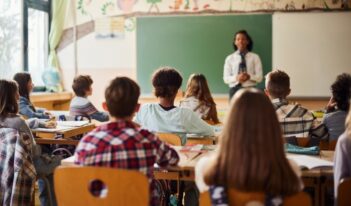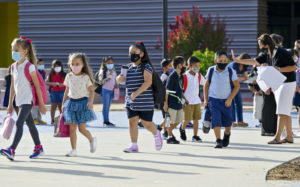
Experts explore childhood education regulation amid a pandemic environment.
The COVID-19 pandemic substantially disrupted traditional methods of teaching and learning, affecting over 1.6 billion students worldwide. By necessitating widespread school closures, the pandemic initiated collective efforts by policymakers and educators alike to adapt the existing education system to the demands of a new world.
Schools abruptly transitioned to remote education with little preparation. Teachers dramatically altered their instructional delivery while parents and students acquired newfound digital expertise. In addition, many states canceled or significantly altered examinations that were federally mandated pre-pandemic, leaving school systems responsible for constructing new means of evaluating the progress of their student body.
The United Nations stated that the pandemic had “stimulated innovation within the education sector.”
Despite these innovations, the pandemic has worsened learning deficiencies amongst K-12 schoolchildren. In the future, these deficiencies may limit the number of qualified college applicants and make high schoolers less likely to pursue postsecondary education. Even after graduation, the pandemic may continue exerting disrupting socioeconomic impacts: one study estimates that pandemic students will make at least $49,000 less over their lifetimes, amounting to a total loss to the U.S. economy of $128 billion per year.
Furthermore, the pandemic exacerbated preexisting educational disparities by disproportionately affecting the most vulnerable children, including those with disabilities and those living in poor or rural areas.
This newfound appreciation for the important role education plays in the lives of children has intensified calls for more permanent change.
Scholars explore the role of regulation in increasing student achievement in the COVID-19 landscape.
- In an issue brief published by the Aurora Institute, Fred A. Jones, Jr. and Alexis Chambers of the Aurora Institute argue that, because most students are performing worse than they were before the pandemic, it would be unjust for the education system to return to its pre-pandemic state. Instead, policymakers should create “innovation zones” allowing schools to obtain breathing room from state regulations that hinder the implementation of novel instructional methods. Jones and Chambers suggest that, when establishing these “innovation zones,” schools commit to innovating in the pursuit of modernized education in exchange for specific flexibilities and exemptions from regulatory requirements. For these programs to work, however, state educational agencies must be willing to transform their agency’s role from one of compliance and enforcement to one focused on innovation and progress, contend Jones and Chambers.
- In an article published in the Journal of Pedagogy, Eric Wearne of Kennesaw State University explains that a number of alternative schooling methods, including “hybrid homeschool” programs, have been on the rise in recent years. Wearne describes how hybrid homeschools, in which students attend classes for some days and are homeschooled on others, exist in a sort of “regulatory gray area” because they are not entirely categorizable as homeschools or as conventional private schools. Hybrid homeschools benefit from “permissionless innovation,” Wearne explains, because existing regulations generally permit experimentation with new technologies and models by default. Wearne argues that, because these hybrid homeschools adjust more nimbly to the challenges of the pandemic, policymakers should continue allowing these innovative educational systems to operate free of burdensome regulatory requirements.
- State-level control of regulatory interventions in the education sector provide an opportunity to promote more equitable outcomes, according to William R. Black and Adam C. Rea of the University of South Florida in a policy brief published in the University of South Florida Scholar Commons. Black and Rea critically examine the Every Student Succeeds Act, which calls on states “to detail school improvement efforts based on state-identified needs.” Despite the benefits of affording states flexibility in their approach to school interventions, Black and Rea argue that this decentralization has made it difficult to track progress or standardize metrics across schools.
- In an article published in the Journal of Law & Education, Stephen D. Sugarman of the University of California Berkeley Law School outlines strategies deployed by regulatory reformers in their quest to achieve equal educational opportunity. Sugarman explores how regulation in the education sector interacted with changing approaches to economic regulation over the past 50 years, focusing this analysis on the advancement, or lack thereof, of minority groups. Despite the lack of success of any one regulatory approach, Sugarman remains skeptical of deregulation and instead emphasizes the importance of who is left in charge of regulating education.
- In a report published by the Center on Reinventing Public Education, Christine Pitts and coauthors explore the state of virtual learning as schools reopen and propose a series of steps to improve students’ digital learning outcomes. The Pitts team notes inequitable distribution of broadband, particularly among Black, Latino, and Indigenous households, and argues that policymakers can close the digital divide by investing in digital infrastructure. School districts and state agencies should also place greater emphasis on flexible learning and community-centric models, according to Pitts and her coauthors, to implement “anytime, anywhere” learning policies to adapt to barriers that students may face in accessing classes outside the confines of traditional schooling hours.
- In a working paper published by the Annenberg Institute at Brown University, Kylie L. Anglin of the University of Connecticut examines the impact of “district of innovation” status in Texas public schools, which permits school districts to opt out of certain regulations. Anglin explains that district of innovation schools most frequently exempt themselves from regulations regarding class sizes, school scheduling, and teacher certifications. The exemption of regulations, however, does not produce a positive or substantial impact on learning outcomes or student achievement when compared to schools that did comply with such regulations, Anglin found.
The Saturday Seminar is a weekly feature that aims to put into written form the kind of content that would be conveyed in a live seminar involving regulatory experts. Each week, The Regulatory Review publishes a brief overview of a selected regulatory topic and then distills recent research and scholarly writing on that topic.



